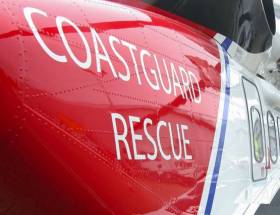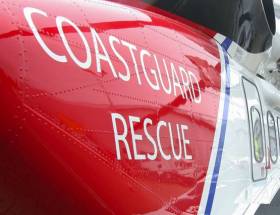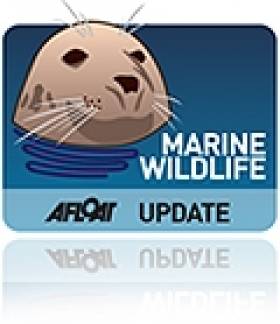Displaying items by tag: Western Isles
For this week's Sailing on Saturday we take a look back eight years when WM Nixon cruised from Ireland to the Outer Hebrides in the 36-foot vintage restored sloop Ainmara
#hebrides – August is almost upon us. The heat has been fierce, and the summer season has been busy. Despite some blips in the weather, civilised folk will be thinking of sailing away from it all for a while. North and west perhaps, in the hope of finding uncrowded and beautiful places which may be cooler. The Western Isles, the Outer Hebrides, are calling us away.
Certainly they did so in August last year, but not for reasons of heat. On the contrary, the jetstream lay persistently along Ireland's south coast, and July's weather here was appalling. But the word came back that up in the Hebrides, they were already thinking of water shortages as the sun shone on and on.
We had contemplated taking the 1912-built 36ft Kearney yawl Ainmara to southwest Ireland for her Centenary cruise. But as owner Dickie Gomes is an enthusiast for the west coast of Scotland in any case, it was no contest. Twelve days in mid-August were allocated to celebrating the old girl's emergence from a 27-year restoration with some Hebridean island-hopping. And I became so taken with the idea that I made an offer that if we could get to the remote little pool of Rodel at the southern tip of Harris, I'd stand my two shipmates the Centenary Dinner at the inn beside that enchanted anchorage.
Rodel is a real honey-trap, as you need a good rise of the tide to get through the drying channel into the deep pool, and there you are - whether you like it or not - until the tide returns. But it's no hardship, as the place is beautiful, the inn is welcoming, and for a thoughtful insight into times past in the Western Isles, just up the road is the restored late mediaeval church of St Clement, complete with the famous MacLeod tomb with its carving of a sailing vessel, the inspiration for Wallace Clark's building of the Lord of the Isles galley with which he voyaged from Connacht to Stornoway.
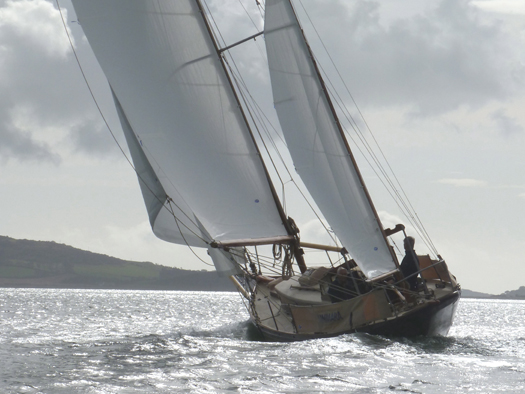 The Centenarian on a silver sea – after a restoration lasting 27 years, Ainmara deserved to spend her hundredth birthday at a very special place Photo: W M Nixon
The Centenarian on a silver sea – after a restoration lasting 27 years, Ainmara deserved to spend her hundredth birthday at a very special place Photo: W M Nixon
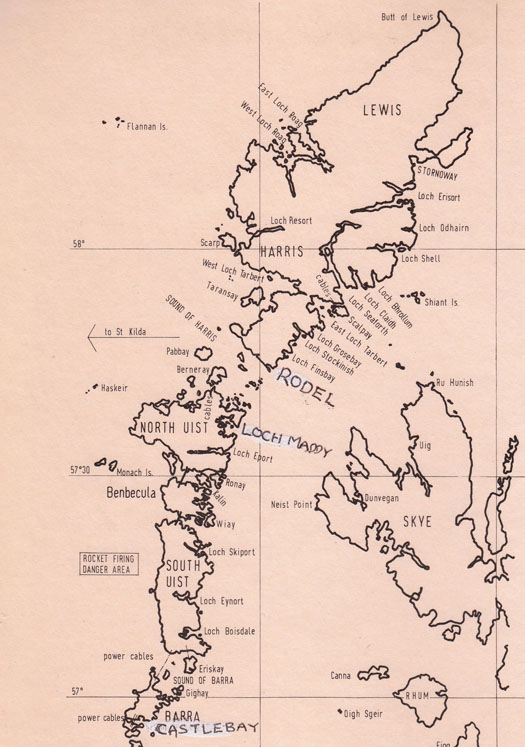 The cruise objective – Rodel is exactly in the middle of the long necklace of the Outer Hebrides
The cruise objective – Rodel is exactly in the middle of the long necklace of the Outer Hebrides
It's the sort of place that everyone thinks they are the first to discover, and my own first discovery of Rodel came in 1977 when we sailed in aboard Johnny Roche's 26ft South Coast OD Safina. The party in the inn was mighty, and dawn was already hinting when we struck a deal in the old kitchen to buy a bolt of Harris tweed, woven within sight of the anchorage. We sailed home with the tweed in a sailbag in the foc's'le, and two of the crew then commissioned that great Dublin tailor Jack O'Rourke (father of current Mermaid National Champion Jonathan O'Rourke) to make them up a couple of suits from our seafaring cloth.
Although they both were of much the same age, one was an old fogey from birth, while the other was a permanently young trendy. So when Jack finally produced the suits to their two very different and clearly defined specifications, it took a real effort to realize that both outfits were cut from the same piece of tweed, as one was a very sharp and fashionable bit of work, while the other had all the timeless style of a sack of potatoes.
Next time back to Rodel was six years later with my own Hustler 30 Turtle, and some of those good folk of Rodel with whom we'd partied in '77 had since gone to the great weaving mill in the sky, while the inn was running out of steam. It still clung to some semblance of gentility with immaculate table linen, but portions for dinner were of such modest size that we simply had two dinners apiece, one after the other.
That was all of thirty years ago, and since then the word was the inn had closed down completely. But a few years ago there was a welcome whisper of a restoration under completely new ownership. So when Ainmara's centenary came up the agenda, it seemed the perfect setting for a mid-cruise Centenary Dinner, and we departed from Ballycastle towards the sunny Hebrides with this interesting cruise objective in mind, while astern the Irish coast continued to lie under cloud.
Despite his impressive record of international long distance offshore racing, these days Dickie Gomes takes care to avoid unnecessary nights at sea, so our progress towards Rodel was gentle yet effective, hopping our way via Port Ellen and Ardbeg in Islay, then on to Scalasaig in Colonsay, and then out to Tiree to be nicely placed for the passage across the Sea of the Hebrides to Barra.
There'd been only one other yacht in Gott Bay in Tiree when we arrived, but there were half a dozen getting under way in leisurely style that morning. Ainmara was the only boat to head west out through Gunna Sound between Tiree and Coll into the Sea of the Hebrides, shaping our course for Barra and motoring gently through a large shoal of basking sharks going about their leisurely work. There was a strengthening breeze from the northeast and the soft grey cloud cover was melting away. It may have been three days already since leaving Ballycastle, but coming out through Gunna Sound gave a special feeling of the cruise really getting under way, and it settled into a perfect 40 mile passage, beam reaching in sunshine with everything set to the jib tops'l on its first outing, and the distinctive peaks of the southern outliers of the Western Isles starting to rise above the horizon while still thirty miles ahead.
 First port in the Outer Hebrides - Castlebay in Barra revelled in the August sunshine Photo: W M Nixon
First port in the Outer Hebrides - Castlebay in Barra revelled in the August sunshine Photo: W M Nixon
Castlebay basked in the sun, the heat was solid, and the tarmac on the quayside road was soft in the sun. At first we were in solitary splendour on the visitors mooring nearest Kisimul Castle, that ancient fortress of the MacNeils, but some other boats came in later in the evening. Up in the cool of the pub, glad to be out of the fierce sun, our gallant skipper met so many interesting folk that we were too late to get a booking at the funky little Café Kisimul on the quay, but had a reasonable meal in the hotel above the boat and retired aboard in a state of enchantment at being in the Outer Isles.
The morning brought a crisp easterly and hazy sunshine, so we were away early to make northing through the Sea of the Hebrides. We'd thought to drop into Eriskay for a lunch break, but the sailing was just too good, this was what we'd come for, we just kept going, and began to think that in a day or two we might even get to Rodel. Once the southeasterly headland on South Uist was astern, the sheets were eased and Ainmara settled into her stride with the jib tops'l pulling well, and the ancient mizzen staysail in its Killkenny colours of black and gold making its first appearance after a very long time in storage.
 This is what we came for – glorious sailing in the Sea of the Hebrides with the ancient mizzen staysail (in the Kilkenny colours) pulling well. Photo: W M Nixon
This is what we came for – glorious sailing in the Sea of the Hebrides with the ancient mizzen staysail (in the Kilkenny colours) pulling well. Photo: W M Nixon
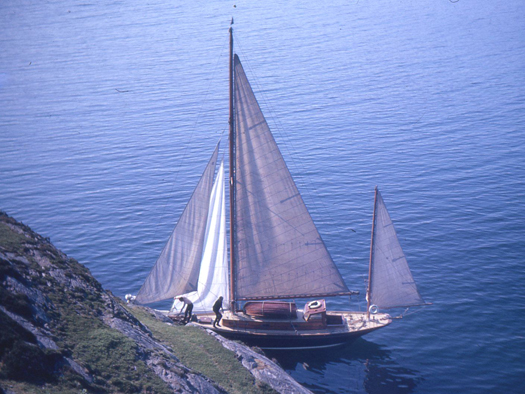 God be with the days.....Ainmara alongside the cliff at Loch Boisdale in June 1963 to collect a bunch of heather for the bowsprit end Photo: W M Nixon
God be with the days.....Ainmara alongside the cliff at Loch Boisdale in June 1963 to collect a bunch of heather for the bowsprit end Photo: W M Nixon
With progress like this, where on earth were we going to stop? Northward she romped, passing Loch Boisdale almost without a thought. Back in 1963 on our first cruise to the Outer Hebrides with Ainmara (when I already thought she was rather an old boat), one fine June morning we were gliding seawards down Loch Boiusdale, and noticed a healthy growth of heather on the nearby cliff. Once you've got north of Ardnmurchan Point, Scotland's Cape Horn, you're entitled to have a bundle of heather on the stemhead or bowsprit end. We hadn't yet got around to this back in 1963, but on that blissful morning we simply came alongside the steep shore, and nipped up the cliff to get the heather. It was Monday June 10th 1963. It was with some relief at the end of June that we noted the exact Golden Jubilee of that magic morning on Monday June 10th 2013 had passed entirely unmarked. You can have enough of Golden Jubilees.
Onward we sailed in August 2012 with gems of lochs like Eynort, Skipport and Uiskkevagh slipping by as this perfect day progressed. Flodday likewise was missed with cavalier disregard, then by Eport the wind was gone, but we motored on to Loch Maddy (48 miles from Castlebay) as we'd never been there before, and it left barely a dozen miles next day to Rodel.
We liked Loch Maddy, it's very Western Isles with the pier in one place and the village in another, and in the morning there was time for an heroic breakfast before heading down the loch in bright sunshine. There was a fine easterly breeze, and out in open water all plain sail was set and we started making impressive knots towards Rodel. I foolishly remarked that this looked like being the best sail of the cruise. Within minutes, it was as if somebody had knocked off a switch. We'd to motor for a while, then a gentle nor'easter had us beating in very leisurely style, and in mid-afternoon we were off Rodel with an hour or so to go to high water.
 While Loch Rodel itself provides only limited shelter, the pool behind Vallay Island is snug
While Loch Rodel itself provides only limited shelter, the pool behind Vallay Island is snug  The tidal entrance looks tricky enough, but it's worth it for the perfect anchorage within
The tidal entrance looks tricky enough, but it's worth it for the perfect anchorage within 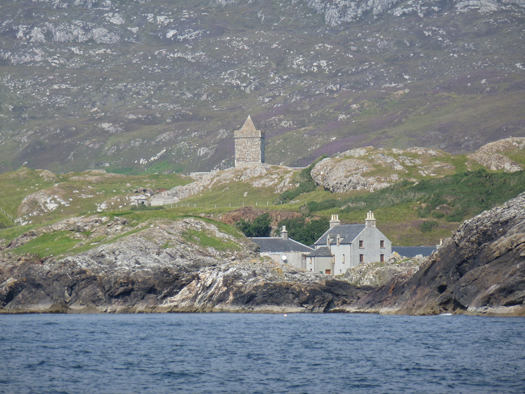 The shoreline begins to take shape, with St Clements Church clear above the hotel at Rodel Photo: W M Nixon
The shoreline begins to take shape, with St Clements Church clear above the hotel at Rodel Photo: W M Nixon
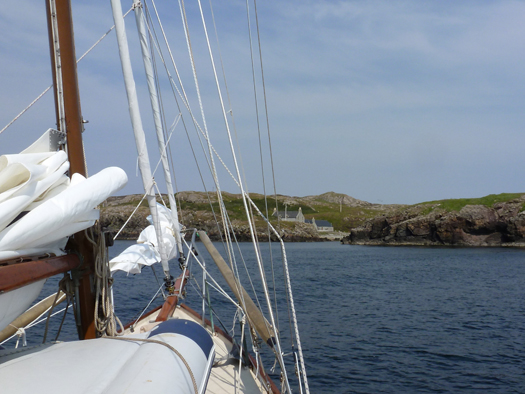 Ainmara is lining up for the Bay Channel into the pool Photo: W M Nixon
Ainmara is lining up for the Bay Channel into the pool Photo: W M Nixon
 The seabed is clearly visible as you pass through the channel close to the port hand marker Photo: W M Nixon
The seabed is clearly visible as you pass through the channel close to the port hand marker Photo: W M Nixon
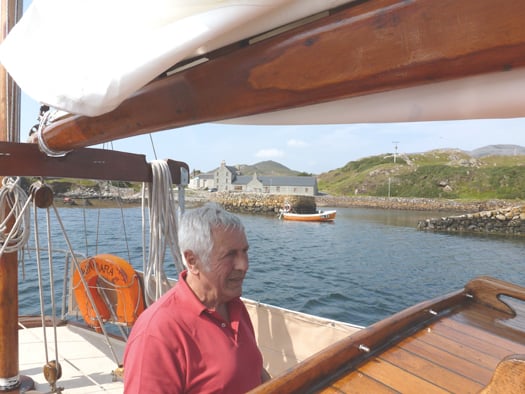 A very relieved skipper as we start to find deeper water in the pool Photo: W M Nixon
A very relieved skipper as we start to find deeper water in the pool Photo: W M Nixon
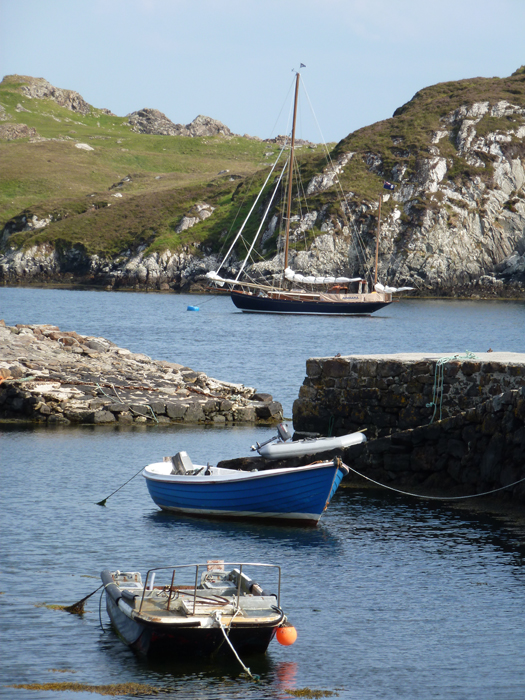 Mission accomplished – Ainmara in Rodel to celebrate her Centenary Photo: W M Nixon
Mission accomplished – Ainmara in Rodel to celebrate her Centenary Photo: W M Nixon
But as tides were neaps, the skipper was a bit nervous as we found our way through the shoal entrance in gentle style. You really do pass very close to the port hand marker. Yet once within the pool, my shipmates saw why I was so keen about this enchanting place, and we happily slowed down to Rodel speed for the rest of the day.
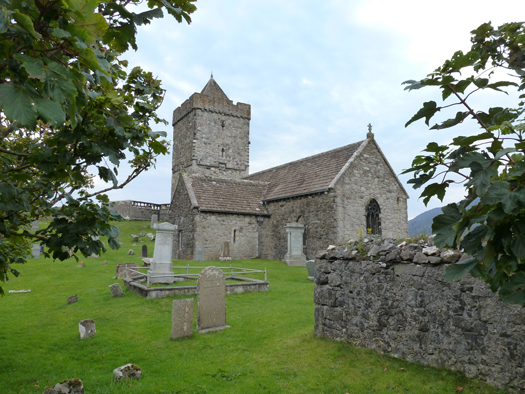 St Clement's Church at Rodel is one of the Outer Hebrides more significant buildings Photo: W M Nixon
St Clement's Church at Rodel is one of the Outer Hebrides more significant buildings Photo: W M Nixon The historic Macleod tomb in St Clement's Photo: W M Nixon
The historic Macleod tomb in St Clement's Photo: W M Nixon
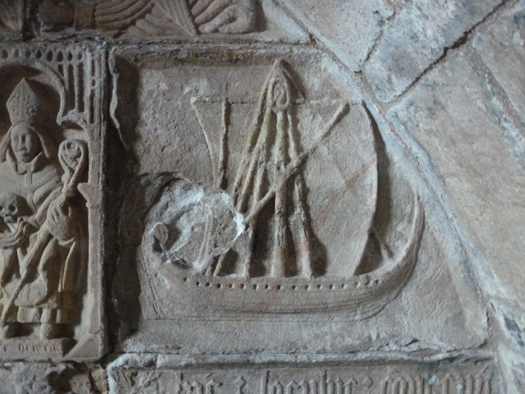 The stone carving on the MacLeod tomb which inspired the Lord of the Isles galley to be built in Greencastle in Donegal Photo: W M Nixon
The stone carving on the MacLeod tomb which inspired the Lord of the Isles galley to be built in Greencastle in Donegal Photo: W M Nixon
Ashore, a visit to St Clements Church fitted the mood perfectly. There is a genuine sense of the past, and of the turbulent history which had once been the lot of this sleepy and now remote place. Down at the restored inn (it's called the Rodel Hotel these days, but for me it will always be the inn), we found the sympathetically-renovated establishment had a new dining room beside a new bar – the old rough bar out the back where we'd started negotiating for the tweed was long gone. And though the Countess of Dunmore's drawing room cum dining room where we'd enjoyed fine linen still exists, it is boarded up. But everything else is very much alive, we were able to have luxurious baths in Jock's Room (thanks Jock) and the setting was perfect with the evening sun still bright on the Centenarian sitting gracefully on her mooring and well visible through the restaurant windows, while the food aspirations were up to speed with a German chef and a friendly and obliging Spanish husband and wife couple front of house.
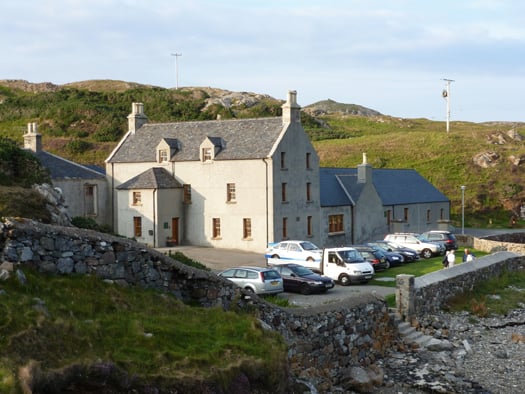 The Rodel Hotel has been restored in a manner which respects its original style. Photo: W M Nixon
The Rodel Hotel has been restored in a manner which respects its original style. Photo: W M Nixon
Appropriately, the skipper had the best of it - he went for the surf'n'turf option which was far from your usual beef and salmon, it was Pabbay venison from the second-last island before St Kilda, combined with Sound of Harris hand-caught scallops. It sounds a bit overpowering, but worked very well, and kept himself in the best of spirits. Denis our third crewman being a sports addict, he was keen to see the Olympics Closing Ceremony on television after dinner, and we were invited to use the Residents' Lounge to do so in comfort. While the lads were settling themselves in there with the coffees and digestifs, I nipped furtively up to the bar to settle the bill - the other two hadn't really believed my "get to Rodel and I'll pay for dinner" proposal - and found what was clearly the man himself running the bar and everything else.
"Would you be our host?" I enquired. "I am indeed," said he, "for my sins I'm the proprietor of this place. Welcome to Rodel. I'm Donald MacDonald".
Such is life. We go all the way, nursing an old boat across hundreds of miles of potentially very turbulent water to Rodel in the Western Isles in order to celebrate her Centenary Feast in the Great Hall of the MacLeods of Harris, only to find it has become a MacDonald's.
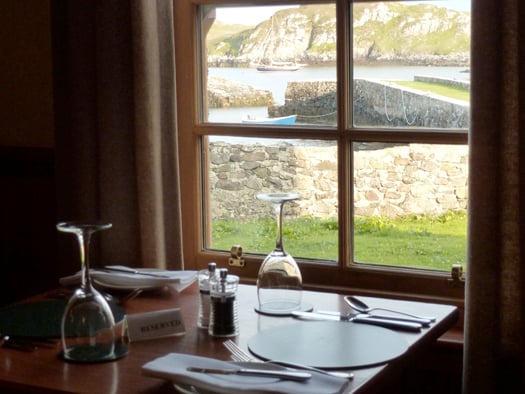 A MacDonald's with a difference – Ainmara serene in the evening sunshine at Poll an Tigh-Mhail, seen from the dining room in the Rodel Hotel. Photo: W M Nixon
A MacDonald's with a difference – Ainmara serene in the evening sunshine at Poll an Tigh-Mhail, seen from the dining room in the Rodel Hotel. Photo: W M Nixon
This article was first published on Afloat on July 27, 2013
#Search - Two bodies have been found in the search for the missing crew of a fishing vessel that sank off Scotland's Western Isles early yesterday (Saturday 9 April).
One crew member was taken to hospital by helicopter as UK Coastguard teams from Stornaway and Prestwick joined the Barra RNLI lifeboat, local fishing vessels and Police Scotland in the search and rescue operation for three missing crewmates, as previously reported on Afloat.ie.
One fisherman remains missing after two bodies were recovered yesterday afternoon off Mingulay. Next of kin are aware and police officers are in contact with the families.
Mark Rodaway, national maritime operations commander for the UK Coastguard, said: “Despite an intensive search including the helicopters, lifeboat and other fishing vessels in the area, we have been unable to locate the missing fisherman. Our thoughts are with all those involved.”
Chief Inspector Alastair Garrow of Police Scotland said: "At this time we can confirm that the bodies of two men have been recovered. A third man was rescued and was taken to hospital at Stornoway. He is not seriously injured.
"A fourth man was on the boat and is still missing. The next of kin of all the men have been informed.
Chief Insp Garrow added: "An investigation will be carried out in parallel with the police and the Marine Accident and Investigation Branch (MAIB) and a report will be submitted to the Procurator Fiscal.
"This has been a tragic incident which will impact on the local community. Our thoughts are with the families affected."
The search has now been scaled back pending further information.
#Search - One crew member from a fishing vessel has been rescued as the search continues for three others after the boat sank off Scotland's Western Isles in the early hours of this morning (Saturday 9 April).
The UK Coastguard received a distress alert just before 3:45am when the fishing vessel with four crew on board has its emergency positioning beacon (EPIRB) activated near Mingulay.
The coastguard search and rescue helicopter based at Stornoway has since been searching the area along with the Barra RNLI lifeboat.
One crew member has been taken to hospital by the helicopter. The lifeboat remains in the area and the coastguard helicopter from Prestwick has taken over so the search can continue.
Sail Away From It All to The Western Isles, the Outer Hebrides
#hebrides – August is almost upon us. The heat has been fierce, and the summer season has been busy. Despite some blips in the weather, civilised folk will be thinking of sailing away from it all for a while. North and west perhaps, in the hope of finding uncrowded and beautiful places which may be cooler. The Western Isles, the Outer Hebrides, are calling us away.
Certainly they did so in August last year, but not for reasons of heat. On the contrary, the jetstream lay persistently along Ireland's south coast, and July's weather here was appalling. But the word came back that up in the Hebrides, they were already thinking of water shortages as the sun shone on and on.
We had contemplated taking the 1912-built 36ft Kearney yawl Ainmara to southwest Ireland for her Centenary cruise. But as owner Dickie Gomes is an enthusiast for the west coast of Scotland in any case, it was no contest. Twelve days in mid-August were allocated to celebrating the old girl's emergence from a 27-year restoration with some Hebridean island-hopping. And I became so taken with the idea that I made an offer that if we could get to the remote little pool of Rodel at the southern tip of Harris, I'd stand my two shipmates the Centenary Dinner at the inn beside that enchanted anchorage.
Rodel is a real honey-trap, as you need a good rise of the tide to get through the drying channel into the deep pool, and there you are - whether you like it or not - until the tide returns. But it's no hardship, as the place is beautiful, the inn is welcoming, and for a thoughtful insight into times past in the Western Isles, just up the road is the restored late mediaeval church of St Clement, complete with the famous MacLeod tomb with its carving of a sailing vessel, the inspiration for Wallace Clark's building of the Lord of the Isles galley with which he voyaged from Connacht to Stornoway.
 The Centenarian on a silver sea – after a restoration lasting 27 years, Ainmara deserved to spend her hundredth birthday at a very special place Photo: W M Nixon
The Centenarian on a silver sea – after a restoration lasting 27 years, Ainmara deserved to spend her hundredth birthday at a very special place Photo: W M Nixon
 The cruise objective – Rodel is exactly in the middle of the long necklace of the Outer Hebrides
The cruise objective – Rodel is exactly in the middle of the long necklace of the Outer Hebrides
It's the sort of place that everyone thinks they are the first to discover, and my own first discovery of Rodel came in 1977 when we sailed in aboard Johnny Roche's 26ft South Coast OD Safina. The party in the inn was mighty, and dawn was already hinting when we struck a deal in the old kitchen to buy a bolt of Harris tweed, woven within sight of the anchorage. We sailed home with the tweed in a sailbag in the foc's'le, and two of the crew then commissioned that great Dublin tailor Jack O'Rourke (father of current Mermaid National Champion Jonathan O'Rourke) to make them up a couple of suits from our seafaring cloth.
Although they both were of much the same age, one was an old fogey from birth, while the other was a permanently young trendy. So when Jack finally produced the suits to their two very different and clearly defined specifications, it took a real effort to realize that both outfits were cut from the same piece of tweed, as one was a very sharp and fashionable bit of work, while the other had all the timeless style of a sack of potatoes.
Next time back to Rodel was six years later with my own Hustler 30 Turtle, and some of those good folk of Rodel with whom we'd partied in '77 had since gone to the great weaving mill in the sky, while the inn was running out of steam. It still clung to some semblance of gentility with immaculate table linen, but portions for dinner were of such modest size that we simply had two dinners apiece, one after the other.
That was all of thirty years ago, and since then the word was the inn had closed down completely. But a few years ago there was a welcome whisper of a restoration under completely new ownership. So when Ainmara's centenary came up the agenda, it seemed the perfect setting for a mid-cruise Centenary Dinner, and we departed from Ballycastle towards the sunny Hebrides with this interesting cruise objective in mind, while astern the Irish coast continued to lie under cloud.
Despite his impressive record of international long distance offshore racing, these days Dickie Gomes takes care to avoid unnecessary nights at sea, so our progress towards Rodel was gentle yet effective, hopping our way via Port Ellen and Ardbeg in Islay, then on to Scalasaig in Colonsay, and then out to Tiree to be nicely placed for the passage across the Sea of the Hebrides to Barra.
There'd been only one other yacht in Gott Bay in Tiree when we arrived, but there were half a dozen getting under way in leisurely style that morning. Ainmara was the only boat to head west out through Gunna Sound between Tiree and Coll into the Sea of the Hebrides, shaping our course for Barra and motoring gently through a large shoal of basking sharks going about their leisurely work. There was a strengthening breeze from the northeast and the soft grey cloud cover was melting away. It may have been three days already since leaving Ballycastle, but coming out through Gunna Sound gave a special feeling of the cruise really getting under way, and it settled into a perfect 40 mile passage, beam reaching in sunshine with everything set to the jib tops'l on its first outing, and the distinctive peaks of the southern outliers of the Western Isles starting to rise above the horizon while still thirty miles ahead.
 First port in the Outer Hebrides - Castlebay in Barra revelled in the August sunshine Photo: W M Nixon
First port in the Outer Hebrides - Castlebay in Barra revelled in the August sunshine Photo: W M Nixon
Castlebay basked in the sun, the heat was solid, and the tarmac on the quayside road was soft in the sun. At first we were in solitary splendour on the visitors mooring nearest Kisimul Castle, that ancient fortress of the MacNeils, but some other boats came in later in the evening. Up in the cool of the pub, glad to be out of the fierce sun, our gallant skipper met so many interesting folk that we were too late to get a booking at the funky little Café Kisimul on the quay, but had a reasonable meal in the hotel above the boat and retired aboard in a state of enchantment at being in the Outer Isles.
The morning brought a crisp easterly and hazy sunshine, so we were away early to make northing through the Sea of the Hebrides. We'd thought to drop into Eriskay for a lunch break, but the sailing was just too good, this was what we'd come for, we just kept going, and began to think that in a day or two we might even get to Rodel. Once the southeasterly headland on South Uist was astern, the sheets were eased and Ainmara settled into her stride with the jib tops'l pulling well, and the ancient mizzen staysail in its Killkenny colours of black and gold making its first appearance after a very long time in storage.
 This is what we came for – glorious sailing in the Sea of the Hebrides with the ancient mizzen staysail (in the Kilkenny colours) pulling well. Photo: W M Nixon
This is what we came for – glorious sailing in the Sea of the Hebrides with the ancient mizzen staysail (in the Kilkenny colours) pulling well. Photo: W M Nixon
 God be with the days.....Ainmara alongside the cliff at Loch Boisdale in June 1963 to collect a bunch of heather for the bowsprit end Photo: W M Nixon
God be with the days.....Ainmara alongside the cliff at Loch Boisdale in June 1963 to collect a bunch of heather for the bowsprit end Photo: W M Nixon
With progress like this, where on earth were we going to stop? Northward she romped, passing Loch Boisdale almost without a thought. Back in 1963 on our first cruise to the Outer Hebrides with Ainmara (when I already thought she was rather an old boat), one fine June morning we were gliding seawards down Loch Boiusdale, and noticed a healthy growth of heather on the nearby cliff. Once you've got north of Ardnmurchan Point, Scotland's Cape Horn, you're entitled to have a bundle of heather on the stemhead or bowsprit end. We hadn't yet got around to this back in 1963, but on that blissful morning we simply came alongside the steep shore, and nipped up the cliff to get the heather. It was Monday June 10th 1963. It was with some relief at the end of June that we noted the exact Golden Jubilee of that magic morning on Monday June 10th 2013 had passed entirely unmarked. You can have enough of Golden Jubilees.
Onward we sailed in August 2012 with gems of lochs like Eynort, Skipport and Uiskkevagh slipping by as this perfect day progressed. Flodday likewise was missed with cavalier disregard, then by Eport the wind was gone, but we motored on to Loch Maddy (48 miles from Castlebay) as we'd never been there before, and it left barely a dozen miles next day to Rodel.
We liked Loch Maddy, it's very Western Isles with the pier in one place and the village in another, and in the morning there was time for an heroic breakfast before heading down the loch in bright sunshine. There was a fine easterly breeze, and out in open water all plain sail was set and we started making impressive knots towards Rodel. I foolishly remarked that this looked like being the best sail of the cruise. Within minutes, it was as if somebody had knocked off a switch. We'd to motor for a while, then a gentle nor'easter had us beating in very leisurely style, and in mid-afternoon we were off Rodel with an hour or so to go to high water.
 While Loch Rodel itself provides only limited shelter, the pool behind Vallay Island is snug
While Loch Rodel itself provides only limited shelter, the pool behind Vallay Island is snug  The tidal entrance looks tricky enough, but it's worth it for the perfect anchorage within
The tidal entrance looks tricky enough, but it's worth it for the perfect anchorage within  The shoreline begins to take shape, with St Clements Church clear above the hotel at Rodel Photo: W M Nixon
The shoreline begins to take shape, with St Clements Church clear above the hotel at Rodel Photo: W M Nixon
 Ainmara is lining up for the Bay Channel into the pool Photo: W M Nixon
Ainmara is lining up for the Bay Channel into the pool Photo: W M Nixon
 The seabed is clearly visible as you pass through the channel close to the port hand marker Photo: W M Nixon
The seabed is clearly visible as you pass through the channel close to the port hand marker Photo: W M Nixon
 A very relieved skipper as we start to find deeper water in the pool Photo: W M Nixon
A very relieved skipper as we start to find deeper water in the pool Photo: W M Nixon
 Mission accomplished – Ainmara in Rodel to celebrate her Centenary Photo: W M Nixon
Mission accomplished – Ainmara in Rodel to celebrate her Centenary Photo: W M Nixon
But as tides were neaps, the skipper was a bit nervous as we found our way through the shoal entrance in gentle style. You really do pass very close to the port hand marker. Yet once within the pool, my shipmates saw why I was so keen about this enchanting place, and we happily slowed down to Rodel speed for the rest of the day.
 St Clement's Church at Rodel is one of the Outer Hebrides more significant buildings Photo: W M Nixon
St Clement's Church at Rodel is one of the Outer Hebrides more significant buildings Photo: W M Nixon The historic Macleod tomb in St Clement's Photo: W M Nixon
The historic Macleod tomb in St Clement's Photo: W M Nixon
 The stone carving on the MacLeod tomb which inspired the Lord of the Isles galley to be built in Greencastle in Donegal Photo: W M Nixon
The stone carving on the MacLeod tomb which inspired the Lord of the Isles galley to be built in Greencastle in Donegal Photo: W M Nixon
Ashore, a visit to St Clements Church fitted the mood perfectly. There is a genuine sense of the past, and of the turbulent history which had once been the lot of this sleepy and now remote place. Down at the restored inn (it's called the Rodel Hotel these days, but for me it will always be the inn), we found the sympathetically-renovated establishment had a new dining room beside a new bar – the old rough bar out the back where we'd started negotiating for the tweed was long gone. And though the Countess of Dunmore's drawing room cum dining room where we'd enjoyed fine linen still exists, it is boarded up. But everything else is very much alive, we were able to have luxurious baths in Jock's Room (thanks Jock) and the setting was perfect with the evening sun still bright on the Centenarian sitting gracefully on her mooring and well visible through the restaurant windows, while the food aspirations were up to speed with a German chef and a friendly and obliging Spanish husband and wife couple front of house.
 The Rodel Hotel has been restored in a manner which respects its original style. Photo: W M Nixon
The Rodel Hotel has been restored in a manner which respects its original style. Photo: W M Nixon
Appropriately, the skipper had the best of it - he went for the surf'n'turf option which was far from your usual beef and salmon, it was Pabbay venison from the second-last island before St Kilda, combined with Sound of Harris hand-caught scallops. It sounds a bit overpowering, but worked very well, and kept himself in the best of spirits. Denis our third crewman being a sports addict, he was keen to see the Olympics Closing Ceremony on television after dinner, and we were invited to use the Residents' Lounge to do so in comfort. While the lads were settling themselves in there with the coffees and digestifs, I nipped furtively up to the bar to settle the bill - the other two hadn't really believed my "get to Rodel and I'll pay for dinner" proposal - and found what was clearly the man himself running the bar and everything else.
"Would you be our host?" I enquired. "I am indeed," said he, "for my sins I'm the proprietor of this place. Welcome to Rodel. I'm Donald MacDonald".
Such is life. We go all the way, nursing an old boat across hundreds of miles of potentially very turbulent water to Rodel in the Western Isles in order to celebrate her Centenary Feast in the Great Hall of the MacLeods of Harris, only to find it has become a MacDonald's.
 A MacDonald's with a difference – Ainmara serene in the evening sunshine at Poll an Tigh-Mhail, seen from the dining room in the Rodel Hotel. Photo: W M Nixon
A MacDonald's with a difference – Ainmara serene in the evening sunshine at Poll an Tigh-Mhail, seen from the dining room in the Rodel Hotel. Photo: W M Nixon
Pilot Whales Avoid Mass Stranding in Scotland
Rescuers reports that a pod of around 60 pilot whales at risk of beaching in shallow waters off Scotland's Western Isles appear to be out of danger.
According to The Guardian, the whale pod alarmed conservationists by swmming into Loch Carnan in a remote part of South Uist last Thursday.
The whales have since moved into open water heading south, but Dave Jarvis of British Divers Marine Life Rescue said they were not yet in the clear, as the rocky coastline hosts a number of inlets and bays that could present dangers to the pod.
Some of the whales have injuries to their heads which are believed to be caused by striking the loch's jagged shoreline.
The Guardian has more on the story HERE.



























